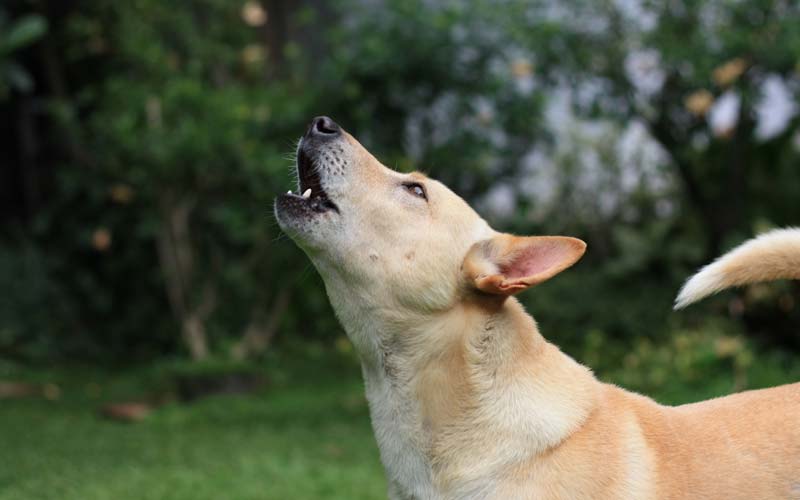Dogs have an incredible ability to communicate with us, whether through their expressive eyes, wagging tails, or the sounds they make. Among these vocalizations, howling stands out as one of the most intriguing and, at times, puzzling behaviors. If your dog frequently howls, you might wonder whether they’re trying to tell you something or simply expressing themselves.

Howling is more than just a sound—it’s a link to your dog’s ancestral roots and a complex form of communication. While it might seem random or excessive at times, there are often clear reasons behind this behavior. From signaling their presence to responding to certain sounds, dogs howl for a variety of reasons that can be emotional, instinctual, or even health-related.
In this article, we’ll delve into the reasons dogs howl, what it might mean for your furry companion, and practical tips for managing excessive vocalizations. Understanding why your dog howls is not only fascinating but can also strengthen the bond you share with your pet. Let’s explore the world of canine howling and uncover the messages behind this age-old behavior.
1. Why Do Dogs Howl?
Understanding why dogs howl begins with their roots. While it may sometimes seem like a quirky or random behavior, howling is deeply tied to instinct, emotion, and even health. Let’s explore the various reasons behind this captivating canine behavior.
A. Ancestral Origins
Howling is one of the oldest forms of communication for dogs, tracing back to their wolf ancestors. In the wild, wolves howl to assemble their pack, warn others of potential dangers, or claim territory. This behavior ensured survival by maintaining social bonds and coordination within the pack.
Modern domestic dogs have retained this instinct, though they no longer need to navigate the wild. When your dog howls, it’s often an echo of these ancient survival behaviors—a reminder of their primal connection to wolves.
B. Communication
For dogs, howling is a versatile communication tool. They use it to convey messages over long distances or in response to environmental stimuli. For example:
- Locating Others: Dogs might howl to signal their presence to other dogs or to their human companions when they feel isolated.
- Signaling Distress: Howling can indicate a need for help, such as when they are stuck, hurt, or anxious.
By howling, your dog is essentially sending out a “call” to connect with others, whether it’s to express joy, frustration, or loneliness.
C. Response to Stimuli
One of the most common triggers for howling is sound. Dogs often howl in reaction to high-pitched or prolonged noises, including:
- Sirens from emergency vehicles.
- Musical instruments or singing.
- Other dogs howling in the neighborhood.
Certain breeds are more prone to this behavior due to their vocal nature. For example:
- Huskies and Malamutes: Known for their loud and dramatic howls, these breeds often vocalize to express themselves.
- Beagles and Coonhounds: Their howling helps them alert handlers during hunting or tracking.
This instinctual response to sounds is a reflection of their heightened sensitivity to auditory cues.
D. Emotional Expression
Howling is not just practical; it’s emotional, too. Dogs may howl as an outlet for feelings such as excitement, stress, or even boredom. For example:
- Excitement: Some dogs howl during play or when they’re thrilled by an upcoming walk.
- Stress or Loneliness: A dog left alone for extended periods may howl to express separation anxiety or a need for companionship.
Separation anxiety, in particular, is a significant trigger for excessive howling. If your dog’s howling is coupled with destructive behavior, pacing, or other signs of distress, they might be struggling with being left alone.
E. Health Concerns
Sometimes, howling can signal that your dog is in discomfort or experiencing a medical issue. Conditions such as injury, illness, or cognitive decline in older dogs may prompt frequent howling.
- Pain: If your dog howls unexpectedly or seems distressed, it could be a sign of pain that requires immediate attention.
- Cognitive Decline: Senior dogs with dementia or other age-related issues may howl more often due to confusion or anxiety.
If your dog’s howling seems unusual or persists without clear triggers, it’s essential to consult your veterinarian to rule out underlying health problems.
By understanding these reasons, you can interpret your dog’s howling more effectively and take steps to ensure they’re happy, healthy, and heard. Would you like more examples or tips on managing specific howling behaviors?

2. Is Your Dog’s Howling Normal or Excessive?
While howling is a natural behavior for dogs, it’s essential to determine whether your dog’s vocalizations fall within the realm of normalcy or indicate a deeper issue. Understanding the difference between occasional and excessive howling can help you identify when intervention is necessary.
Occasional vs. Excessive Howling
Occasional Howling
- Occasional howling is typically a response to specific stimuli or situations. For instance, your dog might howl when hearing a siren, greeting another dog, or expressing excitement during play. This kind of howling is usually brief, predictable, and tied to obvious triggers.
Excessive Howling
- Excessive howling, on the other hand, occurs more frequently and may seem unprovoked or disproportionate to the situation. It can interfere with daily life, disturb your household, or even cause conflict with neighbors. This type of howling is often a symptom of underlying emotional, environmental, or medical issues that need attention.
Signs That Intervention May Be Necessary
If your dog’s howling escalates beyond what seems normal, look for these indicators that professional help or behavioral adjustments may be required:
Prolonged or Repetitive Howling
- If your dog howls for long durations or repeatedly without a clear reason, it may suggest boredom, anxiety, or stress.
- Example: A dog left alone all day might howl continuously as a cry for companionship or stimulation.
Accompanying Behaviors
- Excessive howling often coincides with other concerning behaviors, such as pacing, destructive chewing, or digging.
- Example: A dog suffering from separation anxiety might howl while simultaneously attempting to escape their enclosure or tearing up furniture.
Unusual Triggers
- If your dog begins howling at times or in situations where they never did before, it could signal a change in their emotional state or environment.
- Example: Sudden howling at night despite being calm previously might indicate discomfort, fear, or a response to a new stressor.
Age-Related Changes
- Older dogs may start howling more frequently due to cognitive decline or confusion.
- Example: A senior dog that howls when left alone in familiar spaces may be experiencing age-related anxiety or disorientation.
Signs of Physical Discomfort
- Persistent howling that appears to be random or accompanied by signs of pain, such as limping, whining, or changes in appetite, could indicate a medical problem.
- Example: A dog with an injury or illness may howl as a way to communicate their discomfort.
Why It’s Important to Address Excessive Howling
Ignoring excessive howling can exacerbate the underlying issue, leading to heightened stress for both you and your dog. By addressing the behavior early, you can:
- Improve your dog’s quality of life by resolving their distress.
- Strengthen the bond between you and your pet through better communication.
- Prevent potential conflicts with neighbors or others in your household.
In cases of excessive howling, it’s always wise to consult with a veterinarian or a professional dog behaviorist. They can help pinpoint the root cause and recommend tailored solutions to restore balance and harmony.
Would you like additional suggestions on training methods or solutions for managing excessive howling?

3. How to Manage Your Dog’s Howling
Managing your dog’s howling begins with understanding the reasons behind it. Whether the behavior stems from boredom, anxiety, or a natural response to stimuli, there are practical strategies to address it effectively.
A. Identifying Triggers
To manage howling, start by observing your dog’s behavior to identify patterns or specific triggers:
- Keep a Journal: Note when your dog howls, what’s happening in their environment, and how long it lasts.
- Monitor External Stimuli: Pay attention to common triggers like sirens, other dogs, or particular times of day.
- Recognize Emotional Triggers: Watch for signs of stress or excitement that coincide with howling, such as pacing or wagging.
Once you identify the triggers, you can tailor your approach to managing the behavior more effectively.
B. Training and Desensitization
Training your dog to reduce howling involves consistent techniques and patience:
- Positive Reinforcement: Reward your dog with treats, praise, or toys when they remain quiet in situations that previously triggered howling.
- Ignore Attention-Seeking Howls: Avoid responding to howling meant to gain attention. Instead, reward quiet behavior to teach them that calmness gets positive results.
- Desensitization: Gradually expose your dog to the trigger in a controlled way. For instance, if they howl at sirens, play recordings of sirens at a low volume while rewarding calm behavior. Gradually increase the volume as they become more comfortable.
Teach the “Quiet” Command: Train your dog to associate a verbal cue, such as “Quiet,” with stopping howling. Use rewards to reinforce this behavior.
C. Providing Mental and Physical Stimulation
A bored or under-stimulated dog is more likely to howl. Ensure your dog gets the engagement they need:
- Daily Exercise: Provide regular walks, runs, or play sessions to help expend excess energy.
- Interactive Toys: Offer puzzle toys or treat-dispensing toys to keep your dog mentally stimulated when you’re not around.
- Training Games: Incorporate obedience training or games like hide-and-seek to challenge their mind and reinforce good behavior.
Meeting your dog’s physical and mental needs can significantly reduce boredom-related howling.
D. Reducing Anxiety
For dogs that howl due to anxiety, creating a comforting environment can make a big difference:
- Gradual Desensitization: Slowly accustom your dog to being alone by leaving them for short periods and gradually increasing the time.
- Comforting Items: Leave familiar items like a piece of your clothing or their favorite toy to provide a sense of security.
- Calming Aids: Consider using products like pheromone diffusers, anxiety wraps, or calming music designed for dogs.
- Create a Safe Space: Designate a quiet area with their bed, toys, and water where they can feel secure when you’re away.
Reducing your dog’s stress levels can help curb howling caused by anxiety or fear.
E. Professional Help
If your dog’s howling persists despite your efforts, consulting a professional may be necessary:
- Veterinarian: Rule out any underlying medical issues that could be causing pain or discomfort.
- Animal Behaviorist: Work with a certified behaviorist to develop a customized plan tailored to your dog’s needs.
- Obedience Classes: Enroll in classes to address behavioral challenges and strengthen your bond with your dog.
Professional guidance ensures that you’re addressing the root causes of excessive howling and implementing effective solutions.
By identifying triggers, applying training techniques, and ensuring your dog’s overall well-being, you can successfully manage their howling. Remember, consistency and patience are key to helping your furry friend find their calm. Would you like examples of specific training exercises or calming products to include?

4. When to Worry About Your Dog’s Howling
While occasional howling is a normal behavior for dogs, there are times when it might signal a deeper issue that requires immediate attention. Recognizing when howling is a cause for concern can help ensure your dog’s well-being and address potential problems early.
Scenarios That May Indicate a Problem
Sudden Onset of Howling
- If your dog begins howling out of nowhere without any apparent trigger, it could be a sign of discomfort or distress.
- Possible Causes: Pain from an injury, sudden illness, or a reaction to a new environmental stressor.
Persistent or Excessive Howling
- When your dog howls continuously, even in the absence of stimuli, it could point to underlying issues.
- Possible Causes: Anxiety disorders, cognitive dysfunction in older dogs, or sensory impairments like hearing loss.
Howling Accompanied by Other Symptoms
- Pay attention if howling occurs alongside symptoms such as limping, vomiting, excessive drooling, or lethargy.
- Possible Causes: These symptoms may indicate medical emergencies such as injury, poisoning, or illness.
Behavioral Changes
- If your dog’s howling is accompanied by significant shifts in behavior, such as aggression, withdrawal, or destructive tendencies, it may signal emotional or psychological distress.
- Possible Causes: Separation anxiety, depression, or environmental changes like moving to a new home.
Age-Related Howling
- Senior dogs that begin howling frequently may be experiencing age-related issues.
- Possible Causes: Cognitive dysfunction syndrome (similar to dementia in humans) or physical discomfort related to aging.
When to Seek Professional Advice
If you notice any of the following, it’s crucial to consult a veterinarian or animal behaviorist:
- Unexplained or Persistent Howling: A vet can rule out medical conditions or pain that might be causing the behavior.
- Emotional Distress: An animal behaviorist can help identify triggers and create a behavior modification plan.
- Safety Concerns: If howling is paired with signs of aggression or extreme anxiety, professional guidance is essential for safety and effective management.
- Senior Dog Concerns: Older dogs often require specialized care to manage cognitive or physical health issues.
Seeking timely professional advice ensures your dog’s health and happiness while providing peace of mind for you as a pet owner.
By recognizing when howling might indicate an urgent issue, you can act swiftly to support your dog’s needs. Always trust your instincts—if something feels off, it’s better to consult a professional sooner rather than later. Would you like further details on spotting health issues in dogs or steps for finding the right veterinary support?

Conclusion
Howling is a natural, instinctual behavior in dogs, with roots tracing back to their wolf ancestors. While it can be a sign of communication, excitement, or stress, understanding the reasons behind your dog’s howling is key to managing it effectively. From identifying triggers and offering proper training to providing mental stimulation and reducing anxiety, there are several steps you can take to ensure your dog’s howling remains manageable and doesn’t interfere with your household.
However, if the howling becomes excessive, is accompanied by other concerning symptoms, or seems to signal an underlying health issue, seeking professional advice is crucial. A veterinarian or animal behaviorist can help identify and address any medical or behavioral concerns.
Ultimately, by observing your dog closely, providing necessary stimulation, and taking action when needed, you can foster a calm and content environment for both you and your furry friend. Remember, consistency and patience are key—understanding your dog’s needs will lead to a happier, healthier bond.
If you’re noticing any unusual or persistent howling from your dog, don’t hesitate to take action. Consult a professional to ensure your pet’s well-being, and take the necessary steps to keep their behavior in check. Your dog’s comfort and happiness are worth the effort!